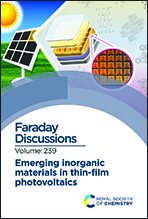Time-resolved photoluminescence studies of perovskite chalcogenides
Abstract
Chalcogenides in the perovskite and related crystal structures (“chalcogenide perovskites” for brevity) may be useful for future optoelectronic and energy-conversion technologies inasmuch as they have good excited-state, ambipolar transport properties. In recent years, several studies have suggested that semiconductors in the Ba–Zr–S system have slow non-radiative recombination rates. Here, we present a time-resolved photoluminescence (TRPL) study of excited-state carrier mobility and recombination rates in the perovskite-structured material BaZrS3, and the related Ruddlesden–Popper phase Ba3Zr2S7. We measure state-of-the-art single crystal samples, to identify properties free from the influence of secondary phases and random grain boundaries. We model and fit the data using a semiconductor physics simulation, to enable more direct determination of key material parameters than is possible with empirical data modeling. We find that both materials have Shockley–Read–Hall recombination lifetimes on the order of 50 ns and excited-state diffusion lengths on the order of 5 μm at room temperature, which bodes well for ambipolar device performance in optoelectronic technologies including thin-film solar cells.

- This article is part of the themed collection: Emerging inorganic materials in thin-film photovoltaics


 Please wait while we load your content...
Please wait while we load your content...